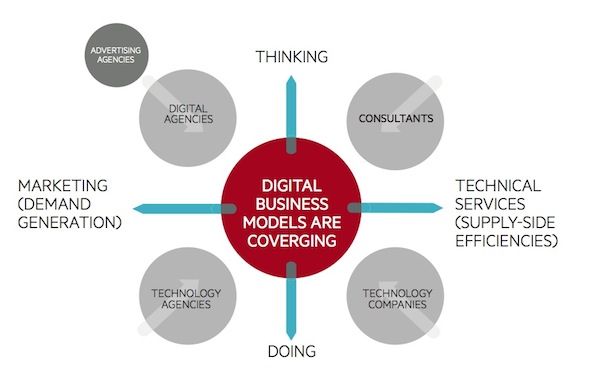Digital Darwinism
Share
With every man and his dog now selling digital marketing services, will the existing agency model survive, or are natural forces gradually producing an entirely new beast?
“I’ve stopped answering my phone when a digital agency calls, and have literally hundreds of messages on my answering machine.” This telling insight into the life of a client-side digital marketer illustrates just how competitive digital service supply has become. Once the domain of ‘traditional’ digital agencies, service provision, whether it be strategy or execution, front-end or back, is becoming an every man’s race.
Digital agencies now find themselves competing against professional services firms, business process outsourcing (BPO) providers, technology companies and other niche players for their share of the pie. With a culture of ‘big data’ invading organisations, ecommerce taking off and consumers consolidating online, digital is taking on greater importance for most businesses, a fact being recognised in the boardroom. While the C-suite has always been hard to crack for marketers, the conversation about how to incorporate digital into the business is increasingly reaching senior management, giving professional services firms something of an advantage. The big consultancies – Deloitte, Accenture, PwC – and technology companies are chipping away at the client base of traditional digital agencies, as the work tendered becomes larger scale, transformational projects integrating back-end processes with front-end initiatives.
As a result, the agency model is under question, as the tussle for business becomes more intense and the future for some becomes more uncertain.
Digital evolution
Predominantly, digital agencies originated from web design backgrounds, and initially specialised in development – sometimes with a bit of strategy ‘tacked on’. Building has been commoditised, now outsourced to cheap overseas centres by both agencies and clients, forcing agencies to beef up the strategy angle. It is a more lucrative model – agencies can charge more for strategy and project management of outsourcing the development side.
Such was the journey for Next Digital, which opened its doors in 1996 as a web development group – although it still has a strong development side. According to the agency’s general manager of client services and marketing, Stephen Lord, it started to evolve a greater focus on marketing services and became more strategically led roughly eight years ago. And its evolution didn’t stop there. “We’ve probably evolved again. We now see our key focus as how we drive value for our customers… business value using a whole range of different digital channels in the most effective mix, and that can be from a creative or a marketing point of view. It can be a technology point of view or even a content point of view,” Lord says.

Today, digital services providers play a number of different roles, and those roles are converging, says managing director of SapientNitro, Paul Bennett. “From my perspective, there is going to continue to be a convergence of creativity, business thinking and technology ‘doing’. The ‘digital agency’ partner of the future for a client is going to be able to do, in one organisation, all three of those things really well. At the moment, clients are still looking at three different organisations to deliver that and therefore it’s not as integrated, not as seamless and not as efficient.”
The structural shift organisations are experiencing as their back-end processes, such as customer relationship management, are digitised and integrated is doing two things: it’s helping digital strategy penetrate the boardroom and giving technology companies a natural advantage. As has long been the case for marketing in general, the boardroom has often been difficult for digital to penetrate. Ad agencies have rarely worked far enough ‘upstream’ to have a say in a company’s strategy. But the big professional services firms are used to working at the top. They’ve seized the opportunity to acquire or create digital services firms, are winning big business and driving companywide change for their clients.
The challenge for the traditional-style digital agency is getting in on the right level. According to Bennett, technology and systems-focused suppliers are seen as more important than the creative agencies and can often command a larger share of budget. “With more money spent on IT than marketing in most organisations, someone who understands how that huge amount of money being spent on it and the marketing budget being spent can complement each other is important,” Bennet says. “A requisite requirement of agencies in the future will be the ability to have as intelligent a conversation with the CIO as with the CMO.”

The battle for the boardroom
While digital agencies may not be in pole position when it comes to queuing for the boardroom, many are finding that the C-level is increasingly receptive to conversations about digital strategy. Lord says that digital has moved up in priority for organisations because it forms such a critical part of their overall business strategy. “Both from a marketing point of view and specifically from a digital perspective, we’re seeing things move in the right direction,” Lord observes.
Lead partner of Deloitte Digital, Frank Farrall, credits the iPad for getting the attention of the top tier. “Since the iPad came out, you can get in and have a conversation about digital, particularly in mobile, with most executives these days,” Farrall says. “They may not have completely connected all the dots around how they might use digital technology as a business, but they now understand how important it is.”
Farrall’s associate Jason Hutchison adds that Deloitte’s reputation for working at a senior level has also been a huge advantage. “Having the Deloitte name behind you makes it a hell of a lot easier to get in front of that top tier. Our brand is used to working with board and C-level execs around business technology transformation, financial advisory and the like. Generally speaking, we have access to that level of executive… bringing the Deloitte brand to that conversation makes it a more serious topic.”
Brian Giesen, head of Social@Ogilvy, has also had positive experiences with senior management. Working in the social space, Giesen sees risk and reputation management as the invitation into the boardroom. “With a lot of our clients, even though we might initially have a conversation through the public relations or the communications department, often times it does lead to conversations or access to the C-suite,” Giesen says. “There’s definitely an open door, but it’s about the topics that you bring into the boardroom, so to speak, with respect to social. Corporate brand reputation and risk management and that sort of thing are a natural way to get the door open.”
From the client’s perspective
Selecting a digital agency is increasing in importance for clients, as audiences not only shift, but consolidate online, and the ability to track them increases the channel’s importance to top tier management. It’s also an increasingly difficult task, as a glut of suppliers flood the market and clamour for the attention of clients.
“I’ve stopped answering my phone at work,” says Lorna Jane’s digital strategist, Sam Zivot. “I have literally hundreds of messages on my answering machine that I haven’t attended to.” Lorna Jane, a women’s active wear retailer, represents a brand at the crest of the digital curve. Its online store does the equivalent sales of 20 of its offline stores, and it’s by no means a small retailer, with 126 retail sites in Australia, South Africa and the US. Zivot primarily uses agencies for higher level development tasks or more technical, performance-side functions, such as search engine marketing, conversions and customer relationship management. But he values input into strategy, and it’s one of the key things he looks for even from a development agency. “Some agencies have given me exactly what I’ve asked for, but then they’re not bringing extra ideation and enhancing my ideas and building on our base of our ideas to build a more successful project. That’s what I really value in my relationships.”
 Clients the size of Tourism Australia (TA) also keep a roster of different agencies, who work with their in-house digital team. For the recent relaunch of ‘There’s nothing like Australia’, TA used DDB’s digital arm, Tribal, to support the online campaign in market. It went offshore for the development of the campaign’s iPad app, which TA’s executive marketing director Nick Baker describes as the glue that joined the dots of the campaign together, contracting US-based PadWorx. And for its websites, TA has used Deloitte for a number of years. Rather than the convenience of a ‘one stop shop’, the choice of supplier often comes down to their capabilities, according to Baker.
Clients the size of Tourism Australia (TA) also keep a roster of different agencies, who work with their in-house digital team. For the recent relaunch of ‘There’s nothing like Australia’, TA used DDB’s digital arm, Tribal, to support the online campaign in market. It went offshore for the development of the campaign’s iPad app, which TA’s executive marketing director Nick Baker describes as the glue that joined the dots of the campaign together, contracting US-based PadWorx. And for its websites, TA has used Deloitte for a number of years. Rather than the convenience of a ‘one stop shop’, the choice of supplier often comes down to their capabilities, according to Baker.
At the small to medium business level, one that is often not seen as profitable to the agency model, Sensis has entered the fray. The company offers a suite of support services to clients, including SEO websites, managed SEM advertising campaigns and an integrated social media strategy. Reflecting on his competitive set, Sensis’ general manager of emerging business and innovation, Simon Betschel, observes, “Drawing a line of distinction between home-based start-up offerings and fully-resourced professional solutions is increasingly difficult.”
Giesen agrees, particularly when it comes to social. “I would say almost every agency in Australia has one or two people that assert the position as the social ‘experts’, and then certainly there are independent people who are out in the marketplace as well.”
The road ahead
The joining of technology with creative is seen as the sweet spot of digital’s future. As businesses integrate their digital processes, suppliers need strong groundings in technology to ensure compatibility end-to-end, and many are also taking the chance to offer company-wide digital implementation. But, beyond just selling technology, an intimate understanding of how it works is also seen as a crucial underpinning of good strategy.
To assert their dominance, the major players are seeking to move into a position in the middle of the continuums of strategy and development and front-end and back-end processes. The agencies, consultancies and technology firms Marketing spoke to expect agencies that sit more on the design side to come together with technology companies and vice versa. The landscape will become more cluttered as major technology and specialist services firms open digital arms or practices in the future, and boutique operators continue to deliver strong niche offerings. Many expect smaller agencies to merge, something that is already occurring in the marketplace.
And who will win the tussle for digital business?
Next Digital’s Lord believes the traditional digital agency is still well-placed to deliver strategy and consulting services, until it becomes a task of tying in changes with the overall business strategy. “If there are significant changes to the business model of organisations, then they certainly have input into that process, but, from a digital point of view, I think the digital agencies still have a very strong role to play in those areas.”
He adds that it is hard to develop a strategy without having a really deep understanding of the whole end-to-end process. “We still think there is a really strong role for technology and development services and how that integrates in with creative and marketing thinking,” he says, “and we see our technology guys as having really important input into our strategy process, because they can offer so much insight around what’s possible and what the potential of the technology is.”
Ogilvy’s Giesen believes strategy and advice will become more important than ever. “I think if other digital agencies follow suit and make that investment, and keep ahead of some of the changes that are happening in the communications landscape, they will be able to compete quite easily with some of those professional services firms.”
Sensis’ Betschel takes more of an objective stance on the future for the digital model, emphasising the relationship and understanding of the client’s business as a key characteristic. “The one prevailing feature for accurate digital strategy development is an intimate and ongoing understanding of the business it is serving.”
SapientNitro’s Bennett has a more ‘blue sky’ outlook on what the future holds for agencies. “The digital agency of the future is not a digital agency at all; it’s an experience agency,” he says. “The digital agency will grow to operating across the whole of the customer ecosystem, from at home to at work, on the way, and out and about, and in-store. The digital agency is going to need to understand and create tools that are useful to consumers in the whole of their lives. That’s the difference between most of today’s digital agencies and the businesses of the future. They will be looking at the whole customer ecosystem and understanding what is the most relevant and most important experiences to connect a brand with its audience.”
Bennett appears to be looking ahead to a day when digital and traditional become one and the same, a day that leaders in industries undergoing structural shifts are beginning to look to also, where connected channels simply form an extension of the offline world, and omni-channel interaction seamlessly joins the dots between the two. Content can then hop back and forth between offline and online, and brands that understand their customers fully and how to best deliver experiences to each individual will be the most successful.
As that day fast approaches, it is a matter of evolution or extinction. The fierce competition digital agencies face will see only the fittest and most agile survive, possibly mutating towards an allencompassing model that redefines what the term ‘full-service’ really means.















